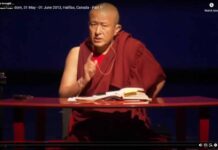It gives me great pleasure that, on the evening of April 4, the communities of the Boulder Shambhala Center and Naropa University will be gathering together at Naropa’s Events Center to celebrate the Parinirvana of Chogyam Trungpa, Rinpoche. This will include a teaching and practice that the Vidyadhara wrote called the Sadhana of Mahamudra, which has particular relevance to these challenging times and includes a feast, celebration, music, dance and poetry by faculty and students. This will be a wonderful introduction for newcomers to the Sadhana, as well as a fresh manifestation of the familiar for others.
It is very tempting, as we celebrate the 20th anniversary of Trungpa’s Parinirvana, to dwell upon the past and to tell stories of the genius that gave birth both to Naropa University and to Shambhala International. It is, of course, a wonderful past and there are many stories to tell. I know we will be sharing many of them. But if I understand the legacy that both Naropa and Shambhala share correctly, our vision ought not to be on the past, but on the present and, by extrapolation, the future. In support of this interpretation, let me offer the following excerpt from Fabrice Midal’s wonderful biography, Chogyam Trungpa: His Life and Vision (pp. 83-84):
Chogyam Trungpa was arguably the most traditional of all Tibetan masters. The word tradition must be understood here in the precise sense of being associated with the source of the teachings.
Chogyam Trungpa might have appeared, at first sight, to be very modern and up-to-date in his approach to the teachings. He had abandoned the external signs of the Tibetan monastic tradition. He drank whiskey, smoked cigarettes, and wore Western clothes. He had a frank, often provocative way with words and ignored the normal conventions of a guru.
But nothing could be further from the truth. For Chogyam Trungpa was arguably the most traditional of all Tibetan masters. The word tradition must be understood here in the precise sense of being associated with the source of the teachings. It thus has nothing to do with the desire to maintain the past for the past’s sake. As Chogyam Trungpa explained, with a humorous touch, “Tradition does not mean dressing up in robes and playing exotic music or having dakinis dancing around us, or anything like that. Tradition is being faithful to what we have been taught and to our own integrity. From this point of view, tradition is being awake and open, welcoming but at the same time stubborn.”‘ Thus, an authentic relationship with Tradition is a matter of purity of heart and not of being a conservative. It is inseparable from the freedom to return, beyond all conventions, to the source.
This distinction between two meanings of the word tradition is of fundamental importance; it allows us to understand the entirety of Chogyam Trungpa’s work as an effort to liberate the first utterance of the teachings from the swamp of habits, customs, and commentaries and from all that is familiar. Chogyam Trungpa reinvented the dharma while remaining absolutely faithful to the Tradition.
Such a paradox is nevertheless possible because the source does not belong to the past but resides in the living present. The Buddha is nowhere if not here, on this patch of earth, now, at this very moment.
In this context, I wish for all of usat Naropa, within Shambhala, and beyonda profoundly Traditional celebration of the Vidyadhara’s Parinirvana.
Below is a video of the event described here by Thomas:
















